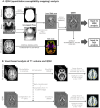Associations Between Cortical Iron Accumulation and Memory in Patients With Amnestic Mild Cognitive Impairment and in Cognitively Normal Individuals
- PMID: 40384339
- PMCID: PMC12086325
- DOI: 10.1002/brb3.70521
Associations Between Cortical Iron Accumulation and Memory in Patients With Amnestic Mild Cognitive Impairment and in Cognitively Normal Individuals
Abstract
Background and purpose: Brain iron accumulation is recognized as a cause and therapeutic target in Alzheimer's disease (AD). We investigated the differences in both volume and iron accumulation between cognitively normal (CN) older adults and patients with amnestic mild cognitive impairment (aMCI). Additionally, we assessed which combination of these measures best explains the group differences in visual and verbal memory performance.
Materials and methods: We retrospectively analyzed data from 48 patients with aMCI and 33 age-matched CN individuals. Structural differences were investigated using voxel-based comparisons of T1-weighted magnetic resonance images. Differences in iron accumulation were investigated using voxel-based comparisons of quantitative susceptibility mapping (QSM) images. Subsequently, significant clusters from these voxel-based analyses (amygdala, posterior cingulate cortex, precuneus, lateral occipital cortex, and pericalcarine cortex) were entered into a stepwise regression to predict verbal and visual memory scores, while accounting for age, sex, and education as covariates.
Results: In comparison to CN, patients with aMCI had significantly lower scores in both verbal and visual memory tests (p < 0.001). The T1-weighted voxel-based morphometry (VBM) results showed significant hippocampal atrophy in the aMCI group relative to CN individuals. The QSM-VBM results showed increased iron accumulation in the amygdala, posterior cingulate cortex, precuneus, lateral occipital cortex, and pericalcarine cortex (FWE-corrected p < 0.05). Lower hippocampal volume (B = 2015.91, SE = 469.61, p < 0.001) and higher posterior cingulate cortex susceptibility (B = -189.63 SE = 89.11, p = 0.037) were significant predictors of verbal memory. For visual memory, higher lateral occipital susceptibility (B = -659. 96, SE = 253.03, p = 0.011) was significant imaging predictor.
Conclusions: These results suggest that iron accumulates in regions where atrophy has not yet occurred, suggesting that iron may serve as an earlier imaging marker of neurodegeneration compared to volume atrophy. Further studies are needed to investigate the longitudinal relationship between brain volume and iron accumulation during cognitive decline.
Keywords: iron; memory; mild cognitive impairment; quantitative susceptibility mapping.
© 2025 The Author(s). Brain and Behavior published by Wiley Periodicals LLC.
Conflict of interest statement
The authors declare no conflicts of interest related to the content of this article.
Figures



Similar articles
-
Quantitative susceptibility mapping to evaluate the early stage of Alzheimer's disease.Neuroimage Clin. 2017 Aug 24;16:429-438. doi: 10.1016/j.nicl.2017.08.019. eCollection 2017. Neuroimage Clin. 2017. PMID: 28879084 Free PMC article.
-
Evaluation and Prediction of Early Alzheimer's Disease Using a Machine Learning-based Optimized Combination-Feature Set on Gray Matter Volume and Quantitative Susceptibility Mapping.Curr Alzheimer Res. 2020;17(5):428-437. doi: 10.2174/1567205017666200624204427. Curr Alzheimer Res. 2020. PMID: 32579502
-
Patterns of Grey Matter Atrophy at Different Stages of Parkinson's and Alzheimer's Diseases and Relation to Cognition.Brain Topogr. 2019 Jan;32(1):142-160. doi: 10.1007/s10548-018-0675-2. Epub 2018 Sep 11. Brain Topogr. 2019. PMID: 30206799
-
Clinical and radiological profile of posterior cortical atrophy and comparison with a group of typical Alzheimer disease and amnestic mild cognitive impairment.Acta Neurol Belg. 2021 Aug;121(4):1009-1018. doi: 10.1007/s13760-020-01547-4. Epub 2020 Nov 23. Acta Neurol Belg. 2021. PMID: 33230741
-
Structural Alteration of Medial Temporal Lobe Subfield in the Amnestic Mild Cognitive Impairment Stage of Alzheimer's Disease.Neural Plast. 2022 Jan 24;2022:8461235. doi: 10.1155/2022/8461235. eCollection 2022. Neural Plast. 2022. PMID: 35111220 Free PMC article.
References
-
- Albert, M. S. , DeKosky S. T., Dickson D., et al. 2011. “The Diagnosis of Mild Cognitive Impairment due to Alzheimer's Disease: Recommendations from the National Institute on Aging‐Alzheimer's Association Workgroups on Diagnostic Guidelines for Alzheimer's Disease.” Alzheimer's & Dementia 7, no. 3: 270–279. 10.1016/j.jalz.2011.03.008. - DOI - PMC - PubMed
MeSH terms
Substances
Grants and funding
LinkOut - more resources
Full Text Sources
Medical

